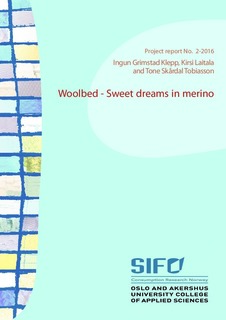Opprinnelsesmerking av norsk ull
Gunnar Vittersø, Ingun Grimstad Klepp, Tone Skårdal Tobiasson og Kjersti Kviseth
Sammendrag
Hensikten med denne rapporten er å undersøke mulighetene for en opprinnelsesmerking av norsk ull. Et slikt merke kan bidra til økt bevissthet og oppmerksomhet om norsk ull både blant produsenter og forbrukere, og dermed styrke produksjon og salg av lokal ull. Rapporten diskuterer en rekke argumenter for en merkeordning. Blant annet at et offisielt merke kan være et hjelpemiddel mot en til dels uryddig markedsføring av ull som vi ser i dag. Dessuten kan det fremme ulike kvaliteter ved norsk ull.
Rapporten bygger på ulike data inkludert intervjuer med aktører i verdikjeden og forbrukerundersøkelser. Erfaringer med merkeordninger fra andre land samt ulike mat-og miljømerkeordninger er også diskutert. Rapporten kan fungere som et kunnskapsgrunnlag for en eventuell etablering av en merkeordning, og den utreder ulike alternative ordninger, men uten å ta stilling til hvordan en merkeordning faktisk bør organiseres.
Klikk her for å lese hele rapporten (oda.oslomet.no)
Summary
The purpose of this report is to examine the possibilities of a labelling scheme for origin of Norwegian wool. A label can help to raise awareness about Norwegian wool among both producers and consumers, thus strengthening production and sales of local wool. Norwegian wool has many properties that seen both from a quality and environmental perspective are favorable. A labelling scheme could also contribute to a more trustworthy marketing of wool. The report builds on diverse data such as interviews with stakeholders in the value chain as well as consumer surveys. Experiences with labelling schemes from other countries as well as different food and environmental labelling schemes are also discussed. The report serves as a knowledge base for the potential establishment of a new labelling scheme. It investigates various alternative arrangements without taking a definite stand on how a labelling scheme actually should be organized.
The full report is only available in Norwegian.
